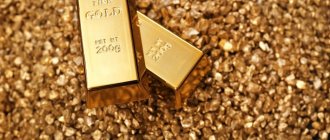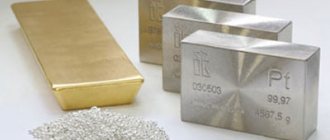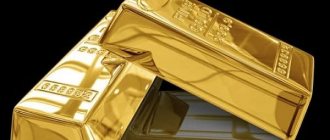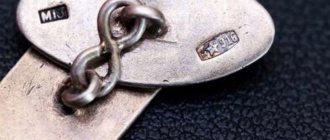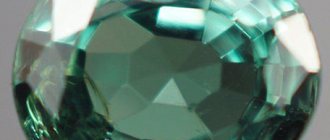Gold solvents are substances that can act on the precious metal and transform the element for some time. Many may ask, why dissolve gold? This process is intended primarily to purify precious metals from impurities and effectively recycle waste.
Dissolving gold in aqua regia
Use of precious metal in various industries
The main industries in which this metal is widely used are:
- jewelry industry;
- creation of modern electrical appliances;
- optics;
- medicine;
- cooking;
- atomic research;
- production of weapons of mass destruction.
Only a tenth of the extracted noble element goes into industry, about 45% ends up in the gold and foreign exchange reserves of states and private individuals. The rest of the metal is used to make jewelry.
Hydrochloric acid and hydrogen peroxide
If you can’t sell radio components in Moscow, and the chemical method is not suitable, then you can use a solution of hydrochloric acid and hydrogen peroxide in a ratio of 2 to 1. After preparing the solution, you should take a container, place the radio components there and fill them with acid. Then the container is set aside for a week. The parts need to be stirred periodically (at least once a day). If everything was done correctly, then over time the solution will darken, and gold particles will appear at the bottom of the dish. Then the precious metal should be washed. To do this, you can use distilled water.
It is better not to touch such gold with your hands - simply touching it can turn it into dust. In order for gold to be conveniently stored, it must be melted in a muffle furnace. Some people make such furnaces with their own hands, but when making them, you need to take into account that gold melts at a temperature of 1000 degrees.
The main disadvantage of this method is that the output is only 90% of the gold that was contained in the radio components. 10% will remain in solution. Also, the resulting gold will not be of the highest standard, and subsequent purification will lead to even greater losses of metal.
History of the development of gold-bearing veins
Archaeologists suggest that gold mining as a branch of the national economy originated in the Middle East. From there, jewelry was exported to Egypt. The first finds in Sumerian tombs are more than 3 thousand years old.
One of the richest cultures in gold reserves was the ancient Inca Empire, which was located in the territory of modern Mexico, Peru and Chile. Their legacy is the mythical golden city of Eldorado, in search of which the Spanish conquistadors went.
In the 15th century, the first deposits were discovered in Mexico, Chile and Ghana. Three centuries later, the first gold mining cooperatives appeared in Russia. In 1823, the richest veins were discovered in Canada and America, which was marked by the outbreak of the famous “gold rush”. Even later, deposits were discovered in South Africa and Australia.
Aqua regia: history of the name, proportion of acids and chemical properties
The properties of Aqua Regia were described even before hydrochloric acid was discovered in the 14th century. The composition became widespread and got its name during the heyday of alchemy on the European continent. The German alchemist Albertus Magnus (of Cologne), who was the mentor of Thomas Aquinas, called it aqua secunda as a derivative of aqua prima, nitric acid.
Translated from Latin: “secondary vodka” and “primary vodka”.
Aqua regia is a very strong acid.
Representatives of the alchemical cohort began to call it royal when Cardinal Bonaventure, classified by Catholicism as the fathers of the church, established that a substance that combined two acids was capable of dissolving the “king of metals.” Previously, it was believed that the noble metal could not be changed by anything. The interaction of aqua regia and gold proved the opposite. In Russia, M.V. Lomonosov called the solution “royal vodka.”
The symbol of Aqua Regia, adopted by alchemists: ▽R. an inverted triangle is a sign of water.
Chemical products, when combined, interact and form a product composition that is highly active. This manifests itself in a strong odor with hints of chlorine and nitrogen dioxide. Nitrogen dioxide gas is yellow in color and resembles smoke of this tone.
At first, aqua regia has no color, but gradually acquires a yellow-orange hue, becoming a very strong oxidizing agent. If it is stored for some time, it gradually decomposes, releasing gaseous substances.
The rate of etching, that is, oxidation, or solubility level, of gold is about 10 µm/min. Other noble metals require heating to certain temperatures for the reaction to occur. This applies to rhodium and iridium. A metal such as silver has other properties. Dissolution in Aqua Regia does not occur; a layer of AgCl, a precious metal chloride, forms on the surface.
Famous gold deposits
An interesting fact is that 90% of all gold production in the world is provided by the ten largest deposits. The richest and most famous include:
- Muruntau, Uzbekistan. According to preliminary estimates, it is 2.5 times more promising than the next field on the list.
- Grassberg, Indonesia.
- Pueblo Viejo, Dominican Republic.
- Yanacocha in the Cajamarca region, Peru.
- Carlin Trend, Nevada, USA.
- Goldstrike mine, which includes 3 deposits, USA.
- Cortez, Nevada, USA.
- Olympics in Russia, Krasnoyarsk region.
- Veladero mine in Argentina.
- Boddington Quarry, Australia.
AllMetals
Gold
Gold is a relatively inert metal; under normal conditions it does not react with most acids and does not form oxides, which is why it was classified as a noble metal, in contrast to ordinary metals, which are easily destroyed by the environment. Then the ability of aqua regia to dissolve gold was discovered, which shook confidence in its inertness.
Over the past centuries, chemists have conducted a huge number of different experiments with gold, and it turned out that gold is not at all as inert as non-specialists think. True, sulfur and oxygen (aggressive towards most metals, especially when heated) have no effect on gold at any temperature. The exception is gold atoms on the surface. At 500–700°C they form an extremely thin but very stable oxide that does not decompose within 12 hours when heated to 800°C. This could be Au2O3 or AuO(OH). Such an oxide layer is found on the surface of grains of native gold.
Gold does not react with hydrogen, nitrogen, phosphorus, carbon, and halogens react with gold when heated to form AuF3, AuCl3, AuBr3 and AuI. It is especially easy to react with chlorine and bromine water already at room temperature. Only chemists encounter these reagents. In everyday life, a danger to gold rings is tincture of iodine - an aqueous-alcohol solution of iodine and potassium iodide: 2Au + I2 + 2KI = 2K[AuI2].
In the series of standard potentials, gold is located to the right of hydrogen, therefore it does not react with non-oxidizing acids. Dissolves in hot selenic acid:
2Au + 6H2SeO4 = Au2(SeO4)3 + 3H2SeO3 + 3H2O,
in concentrated hydrochloric acid when passing through a chlorine solution:
2Au + 3Cl2 + 2HCl = 2H[AuCl4]
By carefully evaporating the resulting solution, yellow crystals of chlorauric acid HAuCl4 3H2O can be obtained.
When gold with tin dichloride, a stable colloidal solution of bright red color (“Cassius purple”) is formed. Gold oxides (AuO2 and Au2O3) can only be obtained by evaporating the metal at high temperature in a vacuum. Red-brown hydroxide Au(OH)3 precipitates when strong alkalis act on the AuCl3 solution. Salts of Au(OH)3 with bases - aurates - are formed when it is dissolved in strong alkalis. Gold reacts with hydrogen, forming a hydride, at a pressure from 28 to 65 * 10-8 Pa and a temperature of more than 3500C. MeAuS sulfoaurates are formed by the reaction of gold with alkali metal hydrosulfides at high temperatures. Gold sulfides Au2S3 and Au2S are known, but the latter are metastable and decompose with the release of a metal phase.
A mixture of concentrated nitric and hydrochloric acids (“aqua regia”) easily dissolves gold: Au + HNO3 + 4HCl = H[AuCl4] + NO + 2H2O. After careful evaporation of the solution, yellow crystals of complex chlorauric acid HAuCl4 ·3H2O are released. The Arabian alchemist Geber, who lived in the 9th and 10th centuries, knew aqua regia, which was capable of dissolving gold.
In concentrated sulfuric acid, gold dissolves in the presence of oxidizing agents: periodic acid, nitric acid, manganese dioxide. In aqueous solutions of cyanides with access to oxygen, gold dissolves to form very strong dicyanoaurates: 4Au + 8NaCN + 2H2O + O2 = 4Na[Au(CN)2] + 4NaOH; this reaction underlies an important industrial method for extracting gold from ores.
Organic gold compounds are also known. Thus, the action of gold(III) chloride on aromatic compounds produces compounds that are resistant to water, oxygen and acids, for example: AuCl3 + C6H6 = C6H5AuCl2 + HCl. Organic gold(I) derivatives are stable only in the presence of ligands coordinated with gold, for example, triethylphosphine: CH3Au·P(C2H5)3.
Profitability and laws
Gold mining on an industrial scale can only be carried out if the deposit is profitable - at least 3 g per ton of ore. If a mine cannot provide this level of metal production, it is recognized as unprofitable, and work on it is stopped.
Until 2021, individuals were prohibited from mining metal even in depleted deposits. Violation of the law entailed punishment including criminal liability. However, the law has been revised, and now gold mining can be carried out by a private individual who has registered an individual entrepreneur.
Extraction of valuable metal is subject to licensing by the Rosnedra organization. Before obtaining permission, the applicant will have to win this right at an auction, and the cost of such a license amounts to billions of rubles if we are talking about promising deposits.
Without obtaining a special permit, you can mine precious metal by concluding a contract with a gold mining organization to carry out work on its territory.
Profit today and prospects for the future
Gold is a measure of the well-being of entire states. As an investment object, it shows a steady increase in value year after year, which makes it an excellent source of investment. According to experts, this trend will continue in the coming years.
Dissolution process
By dissolving gold, it is possible, using subsequent processes, to achieve a higher standard, that is, to increase the amount of precious metal in the alloy. The process occurs in three stages:
- Dissolution of gold with impurities.
- Evaporation.
- Precious metal deposition.
It is for the first stage that solvents are needed. But not every potent substance is suitable for such purposes. Gold is a noble metal, which means the substance is inert in relation to many reagents. But at the same time, there are acids or mixtures that can dissolve gold.
Dissolving is a complex process, but it can be done at home. For example, before cleaning scrap or extracting precious metal from radio components. But before adding reagents to products, it is worth clearing the scrap of impurities. For example, using a magnet to get rid of ferromagnets. Then the scrap can be dipped in nitrous acid to immediately get rid of some of the metals.
How to clean gold plate
Of course, you cannot use any aggressive agents or abrasive cleaning in this case - there is a risk of damaging the thin layer of gold plating. It is better to clean a gold-plated chain, bracelet or ring in the following way:
- Prepare a solution: 1 liter of warm water, 1 tsp. soap shavings, 5-6 drops of ammonia.
- Soak the jewelry for half an hour - they should be completely immersed in the solution.
- Rinse in running water, dry on a napkin or towel.
- Polish with a suede cloth.
How to dissolve gold?
The process of extracting pure gold through its dissolution can be carried out in various ways. Some obtain it by cyanidation.
Cyanidation refers to the extraction procedure using potassium cyanide. Others use fluorine for separation.
It should be noted that this procedure is very dangerous. The fact is that the process is feasible only at extremely high temperatures. In addition, fluorine is one of the most toxic substances in nature.
Also, if there is a need to make 999 from ordinary 585 gold, “aqua regia” will prove to be an indispensable assistant here too.
Gold is highly reactive
In the process of heating gold, an increase in reactivity indicators is observed. That is, the metal can be dissolved during the combination of the oxidizing agent and the sulfuric acid concentrate. As the temperature rises, gold reacts with halogens (including their compounds), as well as with certain types of elements of the system. Note that various jewelry is made not from pure metal, but from its alloy with nickel, copper, and so on. Therefore, it is recommended to store gold with substances that contain iodine and chlorine.
How to Polish Gold
In some cases, it is better to entrust the polishing of jewelry with complex designs to professionals, but you can handle simple jewelry yourself. To make a gold ring shine like new, use the following techniques:
- Soak the jewelry in hot water with shampoo or soap for 7-8 hours, and then polish with a soft toothbrush. The method is suitable for both shiny and matte gold.
- Soaking for 10 hours in an ammonia solution (25%), which can be purchased at a pharmacy, will help to add shine to gold.
- Polishing gold from scratches is done using a cleaning paste for gold items - factory-made or homemade from Vaseline, powdered white chalk, water and soap shavings. Buff with a soft toothbrush without applying pressure.
- Apply GOI paste to the felt, wipe the product with unidirectional movements without pressure: this will help restore shine and effectively polish scuffs and scratches.
Remember: do not use baking soda or tooth powder for polishing - the abrasive particles of these products can only worsen the situation.
The cost of home polishing of gold jewelry is several times lower than professional polishing. But when polishing yourself, it is important to take into account the characteristics of the metal: dullness, color and quality of gold, the presence of jewelry inserts, blackened or rhodium-plated coating.
Gold does not interact with acids and alkalis
Gold is not able to dissolve in an acid-base environment. It can be dissolved only in one case - when combined with aqua regia, which is a concentrate of two acids:
- of hydrochloric acid
- nitric acid
If you look at the works of alchemists of different generations, you can see that they illustrated the research of this reaction in the form of a drawing of a lion that devoured a disk with the sun's rays.
Physical properties of gold
Gold is an element of group 11 of the Periodic Table of Chemical Elements. Of the known 37 isotopes of gold, only one stable isotope occurs in nature - 197Au with an atomic weight of 197, atomic number 79. The remaining isotopes produced in nuclear reactors are unstable and have a maximum half-life of 186 days (195Au).
In 1947, as a result of an experiment in a nuclear reactor, the ancient dream of mankind was realized, which medieval alchemists made their main goal - turning mercury into gold . American physicists Ingram, Hess and Haydn obtained 35 mg of real gold from mercury. Subsequently, there were several attempts to speculate on the topic of industrial production of artificial gold. However, even then, scientists unequivocally stated that obtaining gold in this way was such an expensive process that it did not make any economic sense. As a result, a piece of artificial gold is exhibited at the Museum of Science and Industry in
Chicago , and the
situation remains the same - it is impractical to obtain gold artificially.
Gold is a yellow metal, very heavy, but at the same time soft and ductile.
Gold is the only metal that has a yellow color . The color of gold is bright, warm and pleasant. Thanks to its color, people have associated gold with the sun since ancient times.
The density of gold is 19.32 g/cm3, which means gold is a very heavy metal. The only things heavier than it are platinum, iridium, osmium and rhenium. A cube of gold with a side of only 3.7 cm weighs 1 kg. One cubic meter of gold weighs 19,320 kg, the same volume of iron will weigh almost three times less - 7,874 kg.
The melting point of gold is 1064.43 °C, the boiling point is 2947 °C. Gold in the molten state has a pale green color. When heated above the melting point, it begins to evaporate.
Gold is a very soft metal , with a Mohs hardness of 2.5-3.0. Steel has a hardness of 4.0-4.5, so pure gold can be cut with a knife. In alloys, the hardness of gold increases significantly, which is why we can often see in historical films or books how gold was previously tested “to the teeth.” Indeed, previously issued gold coins consisted of almost pure gold and could be left with a mark when bitten. On counterfeit coins, in which the gold content was lower, it is not possible to leave teeth marks.
Gold is the most malleable metal . Without heating, it can be forged into translucent leaves with a thickness of approximately 1 to 0.1 microns (the thickness of a human hair is from 80 to 110 microns), which will retain the color and all the properties of gold. This is the so-called “leaf” gold, which is used to cover church domes and interior items. One gram of gold produces a sheet with an area of approximately 0.5 m2. Thus, large areas and almost any materials can be decorated with gold. At the same time, the cost of the gold itself will be relatively small and most of the costs will go to pay for the work of the master and related materials.
Gold is a very malleable and malleable metal , which allows it to be given any shape, stretched and compressed, and bent without breaking. For example, from one gram of gold, 100 meters of wire with a diameter of 0.025 mm are obtained, which is used in the electronics industry to create electrical circuits in microcircuits.
Also, the widespread use of gold in the production of microelectronics is ensured by its low electrical resistance , good thermal conductivity and oxidation resistance.
Gold perfectly reflects infrared light . This property is used in glazing systems of high-rise buildings, covering the glass with the finest gold plating, which does not allow infrared rays to penetrate inside and thereby reduces the cost of cooling the building. The visors of the astronauts' helmets are coated with gold. Gold in combination with special plastic completely protects the eyes of astronauts from aggressive infrared and ultraviolet radiation, while transmitting the visible part of light.
Gold lends itself well to various types of processing, polishing, soldering, and easily forms alloys with other metals . All these properties have led to the widespread use of gold for the manufacture of jewelry since ancient times.
How to dissolve gold jewelry step by step?
First of all, if the material is scrap precious metal or a product with impurities, cleaning should be carried out using ferromagnetic intervention.
The process then continues in the form of treatment with pure nitric or other acids. Only after this can you begin direct dissolution.
You should start with accurate measurements of proportions. That is, if the mass of the potential material is 1 gram, you should prepare 3.75 milliliters of concentrated hydrochloric acid, then mix everything in a container.
Almost immediately after mixing, dissolving processes should occur. As soon as the reaction is complete, the solution is drained and repeated as in the first case.
After adding 2 portions of hydrochloric acid, the flask must be heated. During the heating process, the next component in the form of nitric acid is slowly introduced.
Within a short time, the precious metal will completely dissolve, but it should be noted that the definition of completely means exclusively the gold component. Other components, for example, silver, tend to be passivated.
Once the entire process has reached the completion stage, you should wait 20-30 minutes, maintaining the heating temperature at the same level.
Under no circumstances should the heating process be allowed to boil. If this happens, the precious metal will begin to precipitate ahead of time, and this will significantly complicate the further stage of deposition of the aurum in its pure form.




